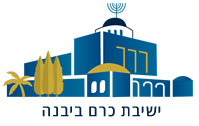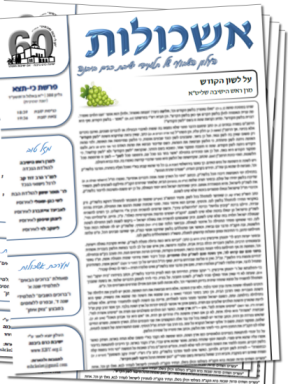פרשת תזריע-מצורע: צרעת הבתים
הרב משה סתיו
Parshat Tazria-Metzora: The Deeper Meaning of Tzara’at HaBatim
“When you come to the land of Cana’an that I am giving to you as a possession, and I place a plague of tzara’at on a house in the land of your possession” (Vayikra 14:33-34). From the language of the pasuk, it seems that the laws that follow only apply if tzara’at appears on a house in Eretz Yisrael, but this is not actually the case. The Ramban writes (13:47) that tzara’at of buildings and clothing is not a natural phenomenon, and there is therefore no need to record the halachot regarding it in chutz la’aretz – because it simply doesn’t happen there. Although the Rambam writes in his commentary on the Mishna that even the halachot of tzara’at of the body have nothing to do with medical illness, others disagree. Yet all agree that there is no scientific explanation for tzara’at of clothing and buildings. Why, then, are all of these afflictions labeled with the same description?
We can expand this question somewhat by investigating the nature of the impurity of the nidda, zava, and zav, which are related to natural phenomenon. What is the connection between these states and impurity? Is there a relationship between the details of these laws and the medical reality?1
Another question related to tzara’at of buildings is the language of “I place” (venatati), which implies a gift. Indeed, Chazal comment that “this is for your benefit,” as the destruction of the houses inflicted with tzara’at revealed the treasures left behind by the Emori’im. But this demands some explanation. If Hashem wanted to reveal those treasures to us, He could have done so in other ways – such as by simply commanding us to destroy all of the houses. Why did He want us to reveal these treasures specifically in this fashion?
We can better understand these points by studying the episodes in which the punishment of tzara’at was inflicted. The first time tzara’at appears in the Torah is in the context of the sign given to Moshe to prove his representation of Hashem; his hand was covered in tzara’at. Although Rashi mentions that this was a punishment for Moshe’s lashon hara regarding Bnei Yisrael, upon closer inspection it is apparent that it is a punishment not for a sin of the tongue per se, but rather for the fact that Moshe belittle Bnei Yisrael. Hashem punishes those who belittle Yisrael. In a similar manner, Hashem punished Pharaoh with nega’im for belittling Sarah Imenu.
The punishment of tzara’at was also inflicted upon those who questioned the institution of the Kehuna, such as King Uzia (who attempted to bring a sacrifice himself). This is hinted to in the pasuk, “And you will not be like Korach and his assembly, as Hashem spoke to him through Moshe” (Bamidbar 17:5). Rashi there comments: “This is a hint to the fact that those who dispute the Kehuna are punished with tzara’at, just as Moshe was afflicted in his hand.” Similarly, Miriam was punished with tzara’at for questioning Moshe’s status. Although it is possible to view her tzara’at as punishment for speaking lashon hara, the pesukim that precede her punishment – Hashem’s explanation of the distinction between Moshe and other nevi’im – imply that her punishment had to do with her lack of appreciation for his lofty level, which justified his separation from his wife.
Sickness is rooted in disruption of the order of the body, and this is true from both the scientific and the spiritual perspectives, and the combination between them: “And He will bless your bread… And I will remove all illness from among you, for I am Hashem, your Healer” (Shemot 15:26).2 In addition, in the relationship between the soul and the body, certain types of disruptions are considered impurity.
In any context in which death is found, we find impurity. Life, the secret of existence, is rooted in the connection to the source and root of existence – the “light of the face” of the Living God. Thus, we request in our tefilla, “Bless us, our Father, with the light of your face, for with the light of your face you have given us… life.” Removal of life leaves behind unperfected material, and therein lie the powers of absence of Divine revelation – including impurity. Korbanot that are removed from the area of the Beit HaMikdash – such as the se’ir hamishtalei’ach and the para aduma – cause impurity, as they have been separated from the inner connection to the place of Divine revelation, leaving room for impurity.3
Commenting on the pasuk, “But to the sons of Avraham’s concubines Avraham gave gifts and sent them away” (Bereishis 25:9), Chazal comment that they were impure. We can understand this based on the theory that we have outlined above. Things that are on a holy level become impure when they are separated from the source of their holiness. This also explains the impurity of the Ov, a power that connects to the soul of a person that is no longer connected to its higher source. Similarly, shichvat zera, nidda blood, and zav emissions represent the potential for life that was disconnected, and they are therefore associated with impurity and death.4 When a person sleeps, he experiences “death” to some extent, and he is therefore in a partial state of impurity. When he awakes, his life force does not return to his extremities – his hands – until he performs an act of purification.
Tzara’t is a form of death, the removal of life, and thus holiness, and this precipitates impurity. For this reason, it is a punishment for sins in which one falls from his spiritual stature, such as the sin of lashon hara. When a person abandons his spiritual level or attempts to attain a level that is higher than his own, the spirit of life of the Shechina departs from him. Thus, Pharaoh was punished with nega’im (unlike Avimelech, who was punished simply with pain) because he damaged Sarah’s spiritual level, and his punishment was midda kenegged midda. Moshe belittled the spiritual level of Yisrael (obviously, on his high level). Those who question the Kehuna, as well as Miriam, who did not appreciate Moshe’s level, were also punished similarly – their own spiritual level was taken from them.
The Divine revelation that creates life and connects to man in Eretz Yisrael – the Divine providence in the Land – transforms the land itself into a living body. For this reason, the same affliction that takes place on the human body appears also on the clothing and houses in Eretz Yisrael, those belonging to the people who are completely connected to the source of life.
The gemara in Ketuvot (112) records a conversation between a Cana’ani and the Jew who had taken over his land. The Cana’ani asked the Jew how much fruit his field produced for him, and the Jew responded that he had harvested sixty kor. The Cana’ani responded, “You just entered, and the land is already ruined! For I produced double that!” This conversation seems strange. Why does the non-Jew who was expelled from the land care how much the land produces now? The non-Jew claimed that Yisrael were not considered to have inherited the land if they did not succeed in settling it and benefiting from it.5 Bnei Yisrael inherit the land only in the merit of their spiritual level.6 The fact that the treasures of the Emori’im remained concealed until Bnei Yisrael revealed them by destroying the houses reflects the fact that it was only at that point – when there was a possibility of nega’ei habattim – that Bnei Yisrael had successfully inherited the land, as the Shechina dwelled there and created a connection even to the land and buildings.
It is only possible to achieve a level of purity of the material and of life itself in Eretz Yisrael, and not in an impure land. Thus, by creating an environment in which the Sechina dwells in one’s property, Bnei Yisrael achieved complete inheritance of the land.
1 This does not negate the fact that there are physical benefits of the mitzvot. Thus, one who rests on Shabbat benefits from the tranquility, and one who keeps kosher avoids unhealthy foods. The Creator of the world and Giver of the Torah wanted to do good for man, and there is therefore a correlation between the mitzvot and their material benefit, just as there is a correlation between a good or bad smell and whether a food is good or bad. However, there is no halachic connection between the mitzva and its benefit. Thus, for example, the Rishonim assumed that birds of prey are impure, as this reflects cruelty in the bird. But if we were to find an “evil” bird that does not have the simanim indicating impurity, or if, conversely, we were to find a “kind” bird that does have the signs, this would not have any clear impact on their status.
2 This is the reason for the dual perspective on doctors, as presented at length by the Ramban.
3 This is the source of the “accusation of the nations” regarding these mitzvot specifically.
4 This is in contrast to bodily waste, which is completely void of any life at all. They are therefore considered disgusting, and therefore distanced, but they are not impure.
5 Conversely, when Bnei Yisrael were exiled, the nations did not succeed in settling the land, proving that it did not belong to them.
6 In my humble opinion, this is why the land is referred to as Eretz Cana’an, as it was only through the destruction of the avoda zara in the land that Bnei Yisrael merited to inherit and conquer the land from the Cana’anim.
קוד השיעור: 7578
לשליחת שאלה או הארה בנוגע לשיעור:

.jpg)

